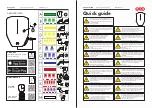
Tire pressure should always be set based on
cold inflation tire pressure. This is defined as the
tire pressure after the vehicle has not been
driven for at least three hours, or driven less
than 1 mile (1.6 km) after a three-hour period.
Refer to “Tires – General Information” in
“Starting and Operating” for information on
how to properly inflate the vehicle’s tires.
The tire pressure will also increase as the
vehicle is driven - this is normal and there
should be no adjustment for this increased
pressure.
The TPMS will warn the driver of a low tire
pressure if the tire pressure falls below the low
pressure warning threshold for any reason,
including low temperature effects, or natural
pressure loss through the tire.
The TPMS will continue to warn the driver of low
tire pressure as long as the condition exists,
and will not turn off until the tire pressure is at or
above recommended cold tire placard pressure.
Once the low tire pressure warning has been
illuminated, the tire pressure must be increased
to the recommended cold tire pressure in order
for the Tire Pressure Monitoring Telltale Light to
be turned off. The system will automatically
update and the Tire Pressure Monitoring Telltale
Light will extinguish once the updated tire pres-
sures have been received. The vehicle may
need to be driven for up to 20 minutes above
15 mph (24 km/h) to receive this information.
For example, your vehicle has a recommended
cold (parked for more than three hours) tire
placard pressure of 33 psi (227 kPa). If the
ambient temperature is 68°F (20°C) and the
measured tire pressure is 28 psi (193 kPa), a
temperature drop to 20°F (-7°C) will decrease
the tire pressure to approximately 24 psi
(165 kPa). This tire pressure is sufficiently low
enough to turn ON the Tire Pressure Monitoring
Telltale Light. Driving the vehicle may cause the
tire pressure to rise to approximately 28 psi
(193 kPa), but the Tire Pressure Monitoring
Telltale Light will still be ON. In this situation, the
Tire Pressure Monitoring Telltale Light will turn
OFF only after the tires have been inflated to the
vehicle’s recommended cold tire pressure
value.
CAUTION!
•
The TPMS has been optimized for the
original equipment tires and wheels. TPMS
pressures have been established for the
tire size equipped on your vehicle. Unde-
sirable system operation or sensor dam-
age may result when using replacement
equipment that is not of the same size,
type, and/or style. Aftermarket wheels can
cause sensor damage. Do not use after-
market tire sealants or balance beads if
your vehicle is equipped with a TPMS, as
damage to the sensors may result.
•
After inspecting or adjusting the tire pres-
sure always reinstall the valve stem cap.
This will prevent moisture and dirt from
entering the valve stem, which could dam-
age the Tire Pressure Monitoring Sensor.
267
Summary of Contents for 2013 Grand Cherokee
Page 1: ...Grand Cherokee O P E R AT I N G I N F O R M AT I O N...
Page 2: ......
Page 3: ......
Page 4: ......
Page 6: ...2...
Page 11: ...7...
Page 66: ...62...
Page 91: ...87...
Page 92: ...88...
Page 93: ...89...
Page 165: ...INSTRUMENT CLUSTER 161...
Page 187: ...Compass Variance Map 183...
Page 218: ...Operating Tips Chart 214...
Page 296: ...292...
Page 372: ...368...
Page 395: ...391...
Page 396: ...392...
Page 397: ...10 INDEX 393...
Page 407: ......
Page 408: ...Chrysler Group LLC 13WK741 126 ENG AB Printed in Europe 13...
















































